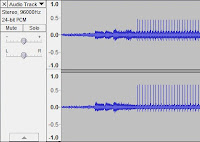Automated software tools are the backbone of the sensor fusion step in the digital transfer process, the step that mines through your source recording to recreate the best possible audio image. However, they cannot replicate your knowledge of what your music is supposed to sound like. And only you can recognize when they have not gone far enough to recreate a full-fidelity image.
Never is this more apparent than in cases where special repairs for old damage are needed.
As you execute the final presentation step of isolating and labeling your tracks, don't speed from track start to expected track end. Examine the wave form as you proceed, looking for blemishes software tools could not correct algorithmically. These include: pops and clicks that somehow did not fit the pattern that cleanup algorithms sought, larger skips, special surface problems. All must be corrected manually.
Do you get more satisfaction out of the bang-for-your-buck from software tools and processes, or from the small hand-crafted victories?
Artist: Chuck Mangione
Genre: Jazz
Year: 1975
 When reviewing this recording, I encountered an odd repeated sound pattern around the 13:00 mark of side one. The "comb" pattern is the hallmark of a "broken record," a permanent defect in the groove wall of an LP that causes a turntable stylus to skip back to the previous groove, endlessly repeating the same 1.8 seconds of audio. In this case, the phenomenon went on for over five minutes before the stylus somehow got jostled enough to get past the defect (otherwise it would still be recording).
When reviewing this recording, I encountered an odd repeated sound pattern around the 13:00 mark of side one. The "comb" pattern is the hallmark of a "broken record," a permanent defect in the groove wall of an LP that causes a turntable stylus to skip back to the previous groove, endlessly repeating the same 1.8 seconds of audio. In this case, the phenomenon went on for over five minutes before the stylus somehow got jostled enough to get past the defect (otherwise it would still be recording).
You can listen to a copy of the affected passage here.
Because automated tools see nothing unusual about oft-repeated audio patterns, one would think the recording is ruined. But a hands-on matching technique was employed to save it. By matching, I mean the sound wave just before the throwaway audio repeats is matched to the wave just after, cutting out the sound in between to effect a smooth transition.
Judge for yourself the quality of the audio match here. If you are interested in the details of the technique, a step-by-step guide is available.
© 2012 Thomas G. Dennehy. All rights reserved.
.jpg)

Do you get more satisfaction out of the bang-for-your-buck from software tools and processes, or from the small hand-crafted victories? Please leave a comment.
ReplyDelete